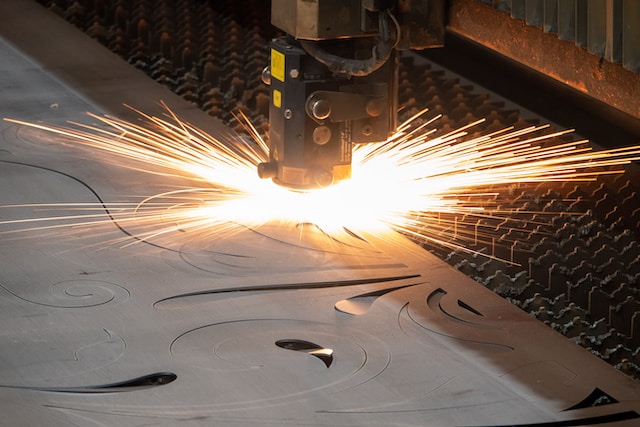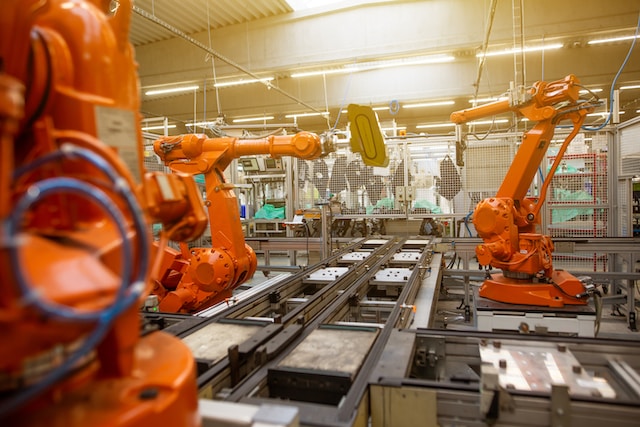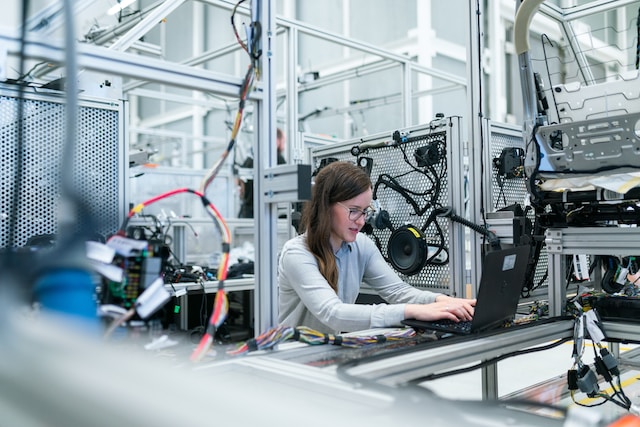The assembly line—established by Henry Ford in his Highland Park automobile factory in 1913—was the first industrial automation system that helped to revolutionise how high-quality products are manufactured. Whilst Ford was focused on dividing his labour force into stations which would carry out specific tasks, his idea to use conveyors and machinery to move unfinished goods between these stations would prove crucial to improving the speed and efficiency of manufacturing.
Since the early 20th century of Ford and the fledgling automotive industry, manufacturing and industrial process automation have advanced rapidly. From robotics and control systems to artificial intelligence-empowered sensors, companies have transformed their operations, reducing the cost to the consumer and increasing profits.
At the same time, concerns have been raised about the impact of industrial automation systems in the broader manufacturing industry.
In this guide, we will explore:
- The growing role of industrial automation systems in the modern “smart factory”
- The industries and regions with the highest uptake of industrial automation technologies and the factors driving their adoption
- How industrial automation systems will change the nature of work within the manufacturing sector.
If you’re interested in learning more about emerging and established technologies that are helping to positively disrupt the industry, see our 2023 guide to Advanced Engineering Sector Trends for an in-depth exploration of how companies are facing supply chain challenges, increasing their profitability, and enhancing employee satisfaction.

What is Industrial Automation?
Industrial automation systems are focused on enhancing manufacturing environments' productivity by using machines instead of humans to perform tasks and manage processes. They aim to reduce labour costs and the potential for human error, helping make goods cheaper for the average consumer and improving on-site safety.
With over 500,000 industrial robots installed in 2021, according to the end-of-year World Robotics Report 2022, manufacturers across the globe are taking advantage of technological advances to minimise costs. The Asia-Pacific region represents the world’s largest market for industrial robotics, accounting for 74% of 2021 installations. China is the most significant adopter, with Japan presenting the second-largest market and the US placing third.
The installation of robotics and industrial automation systems also increased by 24% in the EU over the same period of time. Surprisingly, demand for industrial process automation remained at previous levels in the automotive industry, whilst demand from the general manufacturing industry leapt by 51% over the course of 2021.
The market for industrial automation systems is projected to reach a global value of around $493bn over the next decade—over double the currently available figure of $212.6bn from 2022.
The Five Types of Industrial Automation Systems
Whilst there are many examples of industrial process automation, almost all can be broadly classified into five systems:
- Fixed Automation. This involves using equipment to perform a specific task or set of tasks in a repetitive and consistent manner. An example of this type of automation would be the robotic arms which paint vehicles on an assembly line or the conveyor belts which move those vehicles along the line.
- Programmable Automation. PA focuses on the use of computer-controlled machines to perform varied tasks. Examples of programmable automation can be found throughout the manufacturing environment, for instance, milling machines or lathes that take a professionally-prepared file from CAD software and produce parts or finished goods.
- Flexible Automation. This form of automation utilises robotics to perform a wide range of tasks. Flexible automation systems are designed to be highly adaptable and can be reconfigured to handle different products or manufacturing processes—for example, a robotic device equipped with sensors and vision systems to detect changes in the parts it handles in a factory that regularly switches between different products.
- Integrated Automation. Integrating different automation technologies—such as robots, conveyors, human-computer interfaces and sensors—create a seamless and efficient manufacturing process. A popular example of integrated automation in 2023 is the smart factory, which minimises waste whilst providing a significant level of quality control.
- Collaborative Automation. Robotic devices and humans are commonly found working together in the modern-day manufacturing environment, leveraging both parties’ strengths. These “cobots” are frequently used within the automotive manufacturing process, helping engineers and technicians to install heavy parts onto the chassis of a vehicle or tighten bolts to a specific torque.
Recent advancements in automation technologies have seen some commentators note that a fourth industrial revolution—commonly referred to as Industry 4.0—is underway.
As business leaders continue to recognise the impact IoT-enabled devices, real-time data and advanced sensing technologies can have on profitability, skilled candidates will be required for industrial automation jobs.
How Industrial Process Automation Will Transform Work
By reducing the need for manual labour, robotic devices and other industrial automation systems have caused a widespread shift in the nature of employment within the manufacturing sector.
Skilled labour, knowledge work, and project management roles are growing within the industry, whilst the increased safety and move away from hands-on production has meant that manufacturers are able to provide roles which attract candidates from increasingly diverse backgrounds.
With the burgeoning importance of installing, monitoring, and maintaining automation systems in the smart factory environment, there has been a growing demand for workers with technical skills in areas such as programming, robotic engineering, and data analysis.
Preparing for a Career as an Industrial Automation Engineer
For those candidates looking to enter cutting-edge industrial automation jobs, the first hurdle to pass is obtaining an industry-recognised qualification in the field—whether in electrical, mechanical, or industrial engineering. Postgraduate courses focusing specifically on automation, control systems, and process engineering are also becoming more popular and can prepare engineers for a career transition into working with automation technologies.
It’s crucial that qualified engineers that are looking to enter the sector gain experience. Early-career positions such as Automation Technician can provide candidates with valuable experience in troubleshooting and maintaining industrial process automation technologies and vital soft skills in communication and collaboration with colleagues and external stakeholders.
Candidates interested in a career in the field can also gain experience in roles such as Quality Control Inspector, where they’ll be responsible for ensuring that products meet established standards of quality at different stages of the manufacturing process.
These roles give professionals the ability to develop on-the-job expertise, which can be difficult to impart through formal academic study and expose them to additional skills that can be an asset in industrial automation, such as learning a programming language like C++ or Java.
Building a network and keeping up-to-date with emerging technologies through industry conferences and publications can provide an industrial automation engineer with career progression opportunities. The path for many of these experts is a blend of specialisation and leadership, with roles such as Controls Engineer, Field Systems Engineer, Automation Project Manager, and Senior Industrial Automation Engineer opening up with experience and additional qualifications.
The Advantages of Industrial Automation Systems
With developments in artificial intelligence, machine learning, Internet of Things-connected sensors, and human-computer interfaces offering increased productivity and fine-grained control of processes, these technologies are helping to reduce downtime within the manufacturing sector. But what benefits do they present to employees?
1. Significant increases in productivity. Industrial automation systems are helping to streamline and optimise the manufacturing process. By improving production efficiency, employees benefit from the revenue growth by receiving additional financial support from their employers for learning, development, and other enrichment activities.
At the same time, machines are more efficient at carrying out repetitive tasks, freeing up the humans employed in manufacturing to carry out their more complex responsibilities without the burden of machine operation.
2. Improved quality control. Robots and cobots enable manufacturing professionals to maintain quality results whilst speeding up strenuous or dangerous work that requires accuracy and consistency.
As research conducted for McKinsey & Company’s Global Industrial Robotics Survey shows, 97% of business leaders are already reporting a “positive” or “highly positive” impact on quality due to the manufacturing automation solutions they’ve implemented.
3. A growth in career opportunities. While many are worried about the potential for automation to impact their jobs, the evidence does not support this narrative.
Indeed, a study of the Canadian economy conducted over five years revealed that the increase in manufacturing automation results in more hiring, not less—particularly for technical maintenance and software engineering roles. In fact, not automating could lead to a lack of business competitiveness, meaning that workers need to be made redundant due to a downturn in revenue.
4. Increasingly safe production lines. Robotic devices can perform dangerous tasks, handle hazardous materials, and work in high-risk environments, meaning humans no longer have to be exposed to excessive risk in the manufacturing industry.
Whilst the number of work-related deaths and injuries has significantly reduced since organisations such as the Occupational Safety and Health Administration (OSHA) began their work in the 1970s, there is still more to be done—with manufacturing still representing 15% of all nonfatal injuries in private industry, the growth of industrial automation systems will help to keep future employees healthy and uninjured.
5. Data-driven decision making. Industrial automation provides executive-level staff with a wealth of information from vision systems, sensors, and manufacturing process software.
This raw data will need to be parsed by analysts to provide the insights that empower the presentations that C-suite staff make to internal and external stakeholders. With the growth of cloud technologies, data can now be gathered and analysed from multiple production sites in real time, allowing organisations and their leadership teams to make informed decisions as they monitor key performance indicators to enhance operational efficiency.
Whilst the initial cost of setting up industrial automation systems may be high, it is quickly becoming critical for manufacturing organisations that are looking to innovate and remain competitive.
Far from the potential scenario of reducing personnel, the push toward automation within Industry 4.0 is creating more opportunities for specialists to find new roles within the sector, and for current staff to utilise their time to focus on tasks which improve their skills and open up career progression opportunities.

Parting Thoughts
Clearly, the future is bright for industrial process automation and industrial automation jobs. The shift towards the smart factory means that Industry 4.0 represents a more sustainable revolution in manufacturing processes which is less impacted by supply chain disruption.
Whilst it’s likely that hands-on roles may be lost, business leaders can soften the impact of automation by emphasising the upskilling of their existing workforce.
Providing engineers and manufacturing staff with relevant learning, development, and training opportunities will be crucial in ensuring that job losses remain at a minimum and employers can continue to leverage the knowledge and expertise of their staff.
Engineering Recruitment that Progresses Lives Everywhere
Our team of advanced engineering consultants are subject matter experts committed to connecting talented candidates with market-leading businesses across the sector. Learn more about our services on our specialisms page, or alternatively, contact us to discuss your requirements.






